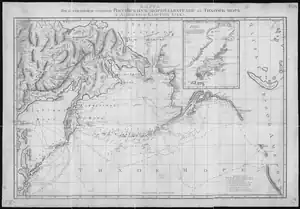Martin Spanberg
Martin Spanberg[1] (d. 1761; Russian: Мартын Петрович Шпанберг, Martyn Petrovich Shpanberg) was a Danish naval officer in Russian service who took part with his compatriot Vitus Bering in both Kamchatka expeditions as second in command. He is best known for finding a sea route to Japan from Russian territory and for exploring the Kuril Islands. Shikotan, one of the Kurils, was renamed in his honor by the Russians in 1796.

Spanberg led three voyages in 1738, 1739, and 1742. On the first of these voyages, Spanberg left 29 June 1738 aboard the Archangel Michael (Архангел Михаил, Arkhangel Mikhail)[2] with his own assistants William Walton (Вильям or Вилим Вальтон, Vilim Valton) and Alexander Shelting (Алексей Елеазарович Шельтинг, Aleksey Yeleazarovich Shel'ting) commanding the Sv. or St. Gabriel (Святой Гавриил, Sviatoi Gavriil) and the Nadezhda (Надежда) respectively. He charted 30 of the Kurils. On the second voyage, he gained a fourth ship—the Bolsheretsk (Большерецк)—and was the first Russian commander to visit Honshu in Japan, establishing Russo-Japanese diplomatic relations.[3] His ships landed in a scenic area now part of the Rikuchu Kaigan National Park but, despite isolationist Japanese sakoku policy of the time, the sailors were treated with courtesy.[3] The second and third voyages also surveyed the coasts of Japan and Sakhalin as well as the Kurils.[4]
Works
Spanberg wrote a brief account of his travels. They pointedly failed to locate the phantom islands of Rica de Oro and Rica de Plata ("Rich in Gold and Silver") supposedly in the area. Producing the first trustworthy account of the region, Spanberg further established that the supposedly enormous Staten Island (Dutch: Staten Eylandt, lit. "States Island") and Company Land (Dutch: Compagnies Landt; French: Terre de la Compagnie) common on European maps after the 1643 visit of Maarten Gerritsz Vries of the Dutch East India Company were either nonexistent or much smaller in extent, grossly misrepresenting some of the Kurils like Urup[1] and Iturup. This was not, however, immediately accepted, and the various phantom islands continued to appear on French and other maps for decades longer.[5]
Honors
Shpanberg Island in the Kurils and Shpanberg Island in the Nordenskiöld Archipelago are named for him.
References
Citations
- Wroth (1944), p. 220.
- Lensen (2017), p. 150.
- Barratt, Glynn (1981). Russia in Pacific Waters, 1715-1825. UBC Press. pp. 35–37. ISBN 9780774801171.
- Quanchi, Max (2005). Historical Dictionary of the Discovery and Exploration of the Pacific Islands. The Scarecrow Press. p. 233. ISBN 0810853957.
- Wroth (1944), p. 222.
Bibliography
- Lensen, George Alexander (2017), "Early Russo-Japanese Relations", Japan and the Pacific, 1540–1920, The Pacific World: Lands, Peoples, and History of the Pacific, 1500–1900, Abingdon: Routledge, ISBN 9781351925549.
- Wroth, Lawrence C. (1944), "The Early Cartography of the Pacific", The Papers of the Bibliographical Society of America, vol. 38, Chicago: University of Chicago Press, pp. 87–231 & 233–268, JSTOR 24301919.